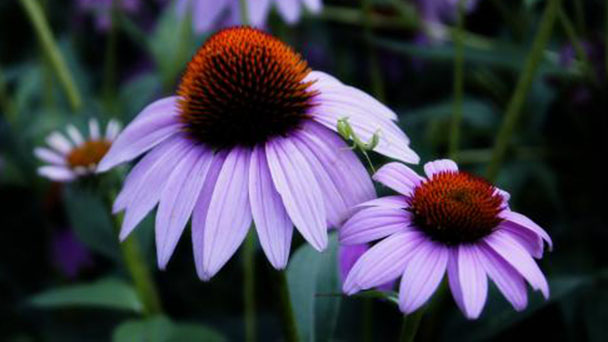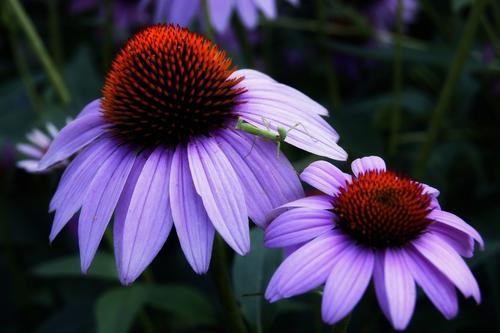How to grow and care for purple coneflower
Written by Maggie
Apr 08 2021

Purple coneflower is a perennial herb of the genus Purple Coneflower and also a wild chrysanthemum. Purple Coneflower is not difficult to care for, because Purple Coneflower is a very easy flower to grow. The following lists how to grow and care for purple coneflower.
When to grow purple coneflower
Varies by zone; sow seeds in spring or fall.
Where to grow purple coneflower
Purple coneflower should be planted in an area that receives 6 to 8 hours of sunlight a day, as too much shade can result in floppy stems and foliage susceptible to powdery mildew.
How to grow purple coneflower
To grow purple coneflower seeds, loosen the soil to a depth of 12 inches. Add compost to the top 2-4 inches of soil. Seeds take approximately 3 to 4 weeks to germinate, and you should see true leaves at about 12 weeks. If transplanting, dig a hole twice as wide as the pot and deep enough so that the root ball will be level with the top of the soil.
How to care for purple coneflower
1. Environment care for growing purple coneflower
When we grow and care for Purple Coneflower, the daytime temperature should be maintained at 16℃-24℃, and the evening temperature should be maintained at 10℃-16℃.
2. Soil care for growing purple coneflower
Purple Coneflower does not require very strict soil requirements. It requires fertile and humus rich soil, which is conducive to the growth of Purple Coneflower.
3. Lighting care for growing purple coneflower
Purple Coneflower is a long-day flower plant. It receives 14-16 hours of light per day during its flowering phase and 7 to 8 weeks of high-intensity light. In the north, it usually blooms in late May.
4. Watering care for growing purple coneflower
Purple Coneflower is strong and drought-resistant. When we grow and care for purple coneflower, we should follow the principle of "see dry see wet" when watering. Wait until the soil in the basin is dry, and then water it all at once.

5. Fertilization care for growing purple coneflower
When we grow and care for purple coneflower, the radicle of Purple Coneflower is 50-75rrg/kg at the stage of cotyledon expansion, 100-150mg/kg at the stage of cotyledon expansion, and 250mg/kg at the stage of colonization. Then the cycle can be applied once or twice a week.
6. Ventilation care for growing purple coneflower
When we grow and care for purple coneflower, it generally should be placed in a ventilated, breathable place for maintenance, be sure to keep the ambient air circulation.
7. Diseases and pests
One problem worth noting in purple coneflower is “aster yellows,” a virus-like disease caused by a phytoplasma. Symptoms are deformed flowers, sometimes with weird tufts in the cones, and yellow leaves with green veins. The organism is spread by sap-sucking insects like leafhoppers (and can also be spread on pruners during deadheading). There’s no cure, so once you notice a plant is infected, dig it up immediately and throw it away. They can also be bothered by leaf miners, powdery mildew, bacterial spots, gray mold, vine weevils, and Japanese beetles.
8. Purple coneflower propagation
Divide clumps when crowded, about every 4 years. If spent flowers are left intact, they will reseed with little effort on your part. Deadheading can help to control this if they are getting out of hand. Some gardeners choose a middle ground and collect the seeds and plant them in carefully selected spots for the following season.

Latest Updated
- Benefits of Bugleweed - 7 Science-backed Health Benefits
- Bugleweed Dangers & Side Effects - Is It Poisonous?
- How to Plant Evergreen Trees - What You Should Know
- When to Plant Evergreens - Grow Guide for Evergreen Trees
- 12 Wonderful Evergreen Shrubs for Your Garden
- 12 Popular Evergreen Plants with Pictures for Beginners
- When And How To Prune A Lilac Bush Like a Pro
- How to Grow & Care for Lilac Vine (Hardenbergia Violacea)
- Japanese Lilac Tree (Syringa Reticulata) Care & Propagation Guide
- Shumard Oak Pros and Cons - What to Know
Popular Articles
- Winter maintenance of Antirrhinum Majus
- How to Grow Terminalia Mantaly Tree
- How to Grow and Care for Crossostephium Chinense
- How to grow Antirrhinum Majus in spring
- Peristeria Elata (Dove Orchid) Profile: Info & Care Guide
- Underwatered Snake Plant (Sansevieria Trifasciata) - Signs And How To Fix
- How to Care for Brazilian Jasmine Plant (Mandevilla Sanderi)
- How to Grow & Care for Graptopetalum Purple Delight in Summer
- Rosa Chinensis (China Rose): Plant Growing & Care Tips
- How to Care for Baby Sun Rose (Aptenia Cordifolia)